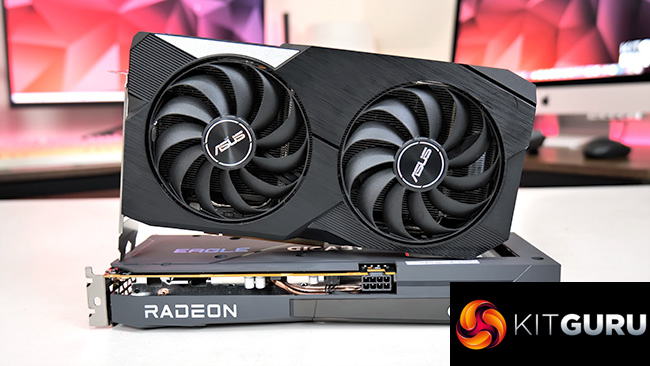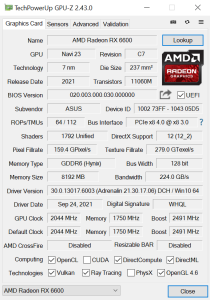Following on from the launch of the RX 6600 XT back in August, today AMD has announced its newest GPU, the RX 6600 (non-XT). Using a cut-down version of Navi 23 silicon, AMD claims the RX 6600 offers ‘powerhouse performance for 1080p', with the company's first-party data showing this new GPU trading blows with Nvidia's RTX 3060. Today we put this new GPU through its paces, comparing it to a range of both current and previous-generation graphics cards.
As with the RX 6600 XT, there's no AMD reference design for the RX 6600, instead AMD is relying on its board partners to come up with their custom designs. Today's review focuses on two such cards – the ASUS RX 6600 Dual and the Gigabyte RX 6600 Eagle. Both are clocked at reference specifications – so there's no factory overclocking involved – though the Eagle uses a triple-fan cooler compared to the dual-fan design of the ASUS… Dual.
In terms of pricing, AMD has set a £299.99 MSRP for the UK market, with a $329 MSRP for those in the US. This is a £30/$50 reduction compared to the RX 6600 XT, though we have been hearing real-world cost is looking closer to £400, if not higher.
Still, we have a review to get on with, so today we are testing the RX 6600 over 12 modern games, comparing it to the likes of the RTX 3060, RX 6600 XT, RX 5600 XT and more. We also have extensive power and performance-per-Watt data, alongside the thermal and acoustic performance of these two custom cards.
| RX 6800 XT | RX 6800 | RX 6700 XT | RX 6600 XT | RX 6600 | |
| Architecture | RDNA 2 | RDNA 2 | RDNA 2 | RDNA 2 | RDNA 2 |
| Manufacturing Process | 7nm | 7nm | 7nm | 7nm | 7nm |
| Transistor Count | 26.8 billion | 26.8 billion | 17.2 billion | 11.1 billion | 11.1 billion |
| Die Size | 519 mm² | 519 mm² | 336 mm² | 237 mm² | 237 mm² |
| Ray Accelerators | 72 | 60 | 40 | 32 | 28 |
| Compute Units | 72 | 60 | 40 | 32 | 28 |
| Stream Processors | 4608 | 3840 | 2560 | 2048 | 1792 |
| Game GPU Clock | Up to 2015MHz | Up to 1815MHz | Up to 2424MHz | Up to 2359MHz | Up to 2044 MHz |
| Boost GPU Clock | Up to 2250MHz | Up to 2105MHz | Up to 2581MHz | Up to 2589MHz | Up to 2491MHz |
| ROPs | 128 | 96 | 64 | 64 | 64 |
| AMD Infinity Cache | 128MB | 128MB | 96MB | 32MB | 32MB |
| Memory | 16GB GDDR6 | 16GB GDDR6 | 12GB GDDR6 | 8GB GDDR6 | 8GB GDDR6 |
| Memory Bandwidth | 512 GB/s | 512 GB/s | 384 GB/s | 256 GB/s | 224 GB/s |
| Memory Interface | 256-bit | 256-bit | 192-bit | 128-bit | 128-bit |
| Board Power | 300W | 250W | 230W | 160W | 132W |
Let's first look over the key specifications of the GPU. Using the same 237 mm² Navi 23 silicon as its XT counterpart, the RX 6600 is cut-back in a few key areas. It houses 28 Compute Units (CUs), so that's four fewer than the 6600 XT, for a total of 1792 stream processors, or 256 fewer than the XT model.
RDNA 2 houses one ray accelerator per CU, so there’s a total of 28 with the RX 6600. Four texture units per CU gives a total of 112, while there’s also 64 ROPs. Clock speed has been pared back slightly though, with a rated boost clock of 2491 MHz, down from 2589MHz with the 6600 XT.
As for the memory configuration, this is broadly the same as the RX 6600 XT, meaning there's a narrow 128-bit memory interface paired with 8GB of GDDR6 memory. The memory itself is clocked slower however, at 14Gbps instead of 16Gbps, reducing total memory bandwidth by 12.5%, as it hits 224 GB/s. There is still 32MB of AMD’s Infinity Cache.
Lastly, total board power (TBP) is rated at 132W, a reduction of 28W, or 17.5%, compared to the RX 6600 XT. We are using our new GPU power testing methodology in this review, so read on for our most detailed power and efficiency testing yet.
 KitGuru KitGuru.net – Tech News | Hardware News | Hardware Reviews | IOS | Mobile | Gaming | Graphics Cards
KitGuru KitGuru.net – Tech News | Hardware News | Hardware Reviews | IOS | Mobile | Gaming | Graphics Cards




